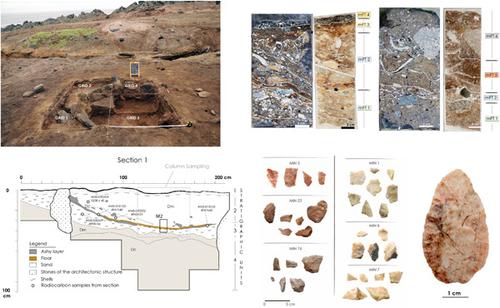当前位置:
X-MOL 学术
›
Geoarchaeology
›
论文详情
Our official English website, www.x-mol.net, welcomes your
feedback! (Note: you will need to create a separate account there.)
Ritual stone-built architecture and shell midden foundation: A semisubterranean structure in hyperarid Atacama Desert coast, Northern Chile
Geoarchaeology ( IF 1.4 ) Pub Date : 2021-05-07 , DOI: 10.1002/gea.21857 Ximena Power 1 , Luca Sitzia 2, 3 , Sebastián Yrarrázaval 4 , Diego Salazar 4 , Pedro Andrade 5 , Valentina Hernández 2 , Catalina Aliste 2 , Xavier Muth 6
Geoarchaeology ( IF 1.4 ) Pub Date : 2021-05-07 , DOI: 10.1002/gea.21857 Ximena Power 1 , Luca Sitzia 2, 3 , Sebastián Yrarrázaval 4 , Diego Salazar 4 , Pedro Andrade 5 , Valentina Hernández 2 , Catalina Aliste 2 , Xavier Muth 6
Affiliation

|
Hunter-gatherer architectural practices are one of the main sources of data to understand the complex land use of these societies. In the hyperarid Atacama Desert coast (Northern Chile), hunter-gatherers-fishers developed standardized stone-built architecture during the Late Archaic period (∼5,700–4,000 cal years BP), interpreted so far as sedentary villages or long-term campsites. Nevertheless, the lack of site formation process studies and systematic chronostratigraphies defy such functional interpretations. To address these issues, we reconstruct the lifecycle of a recently discovered semisubterranean structure at the Zapatero site (~25°S, Taltal). Combining stratigraphy, micromorphology, faunal and lithic analysis, as well as radiocarbon dating, we evidence a broad sequence involving different processes: shell midden formation; a stone-structure; a prepared burial pit; a burning event; a short-term occupational episode; and the entombment of the structure. We interpret this sequence as ritualized actions related to commemorative and place-making activities. Our work stresses the need for new research programs at the Atacama Desert coast, based on geoarchaeological approaches, to understand hunter-gatherer-fisher middening and architectural practices from the very materiality involved in stratigraphy-making processes.
中文翻译:

仪式石砌建筑和贝壳中基础:智利北部极度干旱的阿塔卡马沙漠海岸的半地下结构
狩猎采集建筑实践是了解这些社会复杂土地利用的主要数据来源之一。在极度干旱的阿塔卡马沙漠海岸(智利北部),狩猎-采集者-渔民在古代晚期(约 5,700-4,000 卡年 BP)开发了标准化的石砌建筑,迄今为止被解释为定居村庄或长期露营地。然而,缺乏场地形成过程研究和系统的年代地层学无视这种功能解释。为了解决这些问题,我们重建了最近在萨帕特罗遗址(~25°S,塔尔塔尔)发现的半地下结构的生命周期。结合地层学、微形态学、动物群和岩石分析以及放射性碳测年,我们证明了一个涉及不同过程的广泛序列:贝壳形成;石头结构;准备好的埋葬坑;燃烧事件;短期职业事件;和结构的掩埋。我们将此序列解释为与纪念和场所营造活动相关的仪式化行为。我们的工作强调需要在阿塔卡马沙漠海岸建立新的研究计划,基于地质考古学方法,从地层形成过程所涉及的物质性中了解狩猎-采集-渔民中间化和建筑实践。
更新日期:2021-05-07
中文翻译:

仪式石砌建筑和贝壳中基础:智利北部极度干旱的阿塔卡马沙漠海岸的半地下结构
狩猎采集建筑实践是了解这些社会复杂土地利用的主要数据来源之一。在极度干旱的阿塔卡马沙漠海岸(智利北部),狩猎-采集者-渔民在古代晚期(约 5,700-4,000 卡年 BP)开发了标准化的石砌建筑,迄今为止被解释为定居村庄或长期露营地。然而,缺乏场地形成过程研究和系统的年代地层学无视这种功能解释。为了解决这些问题,我们重建了最近在萨帕特罗遗址(~25°S,塔尔塔尔)发现的半地下结构的生命周期。结合地层学、微形态学、动物群和岩石分析以及放射性碳测年,我们证明了一个涉及不同过程的广泛序列:贝壳形成;石头结构;准备好的埋葬坑;燃烧事件;短期职业事件;和结构的掩埋。我们将此序列解释为与纪念和场所营造活动相关的仪式化行为。我们的工作强调需要在阿塔卡马沙漠海岸建立新的研究计划,基于地质考古学方法,从地层形成过程所涉及的物质性中了解狩猎-采集-渔民中间化和建筑实践。











































 京公网安备 11010802027423号
京公网安备 11010802027423号